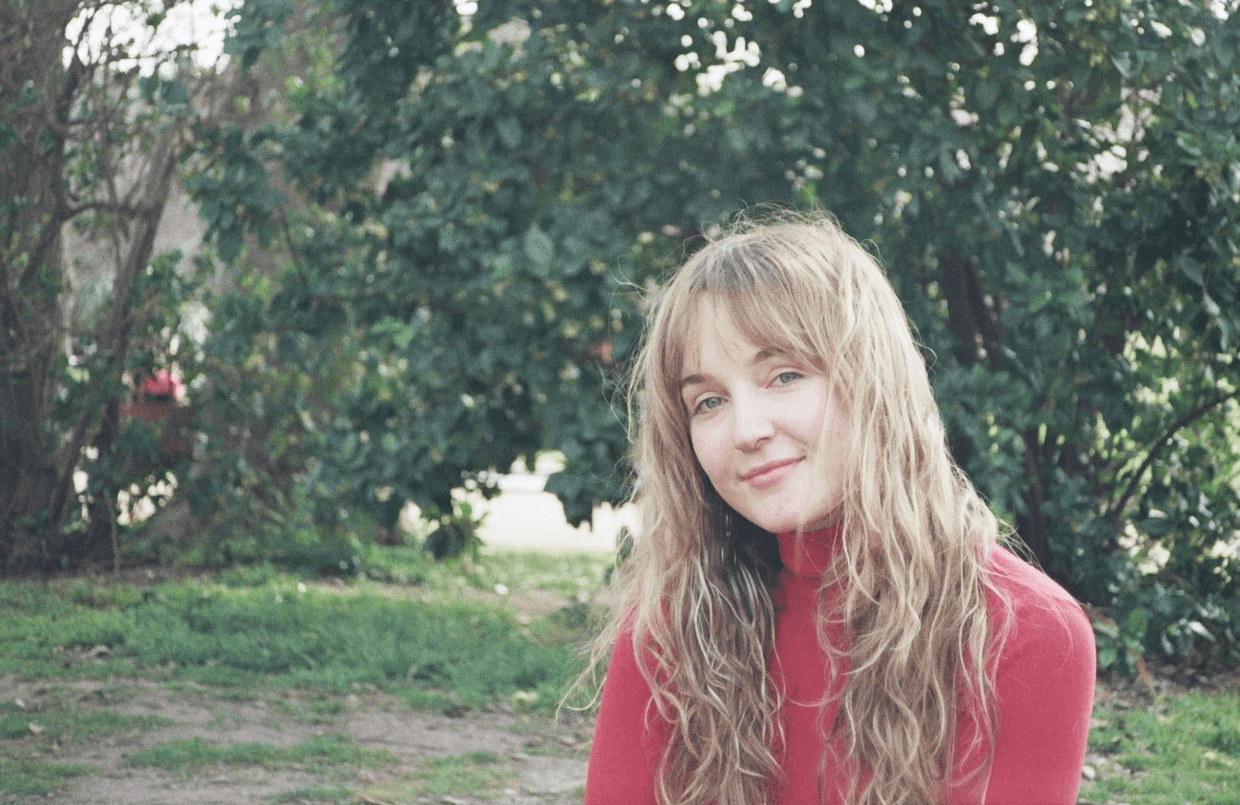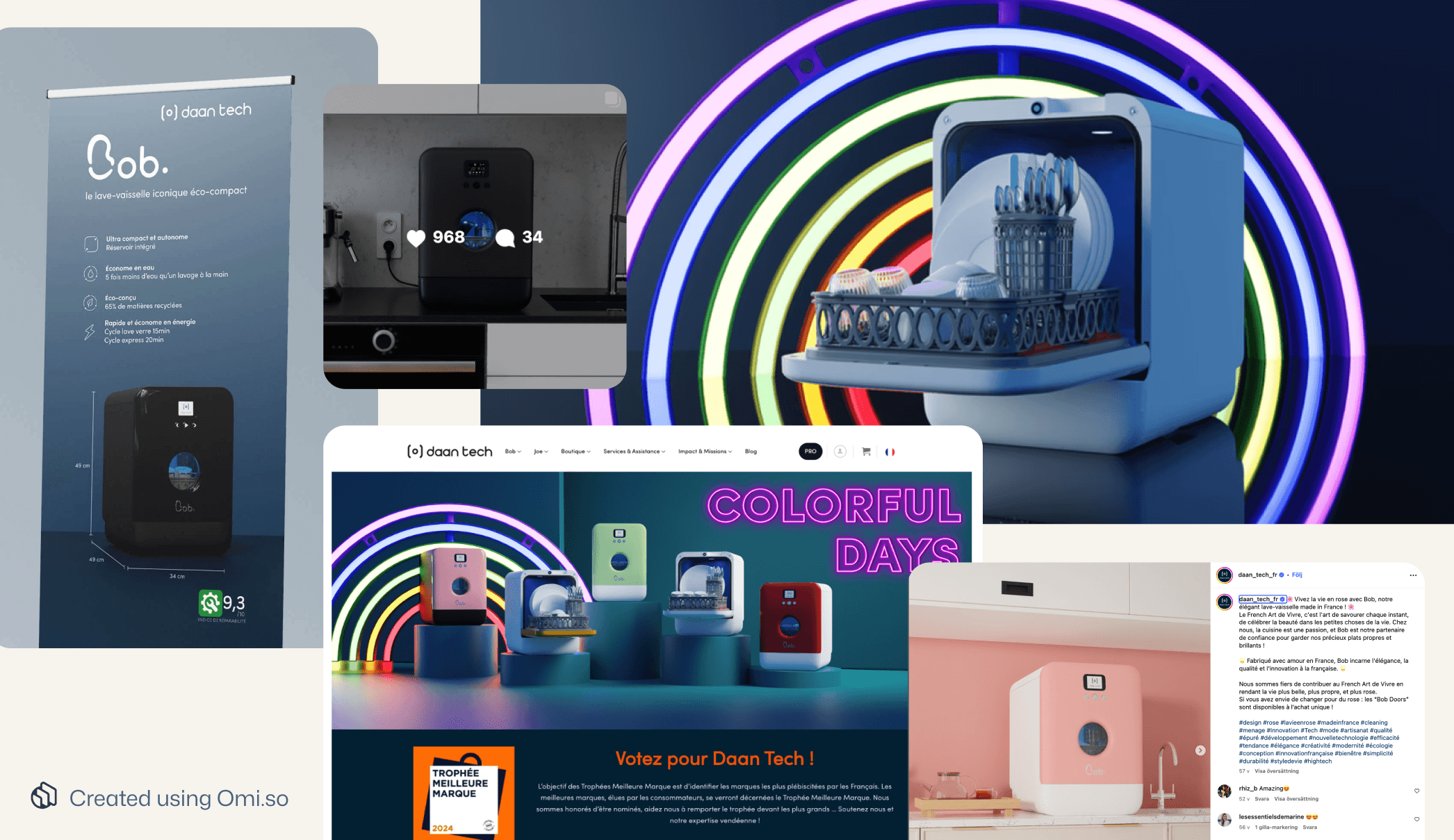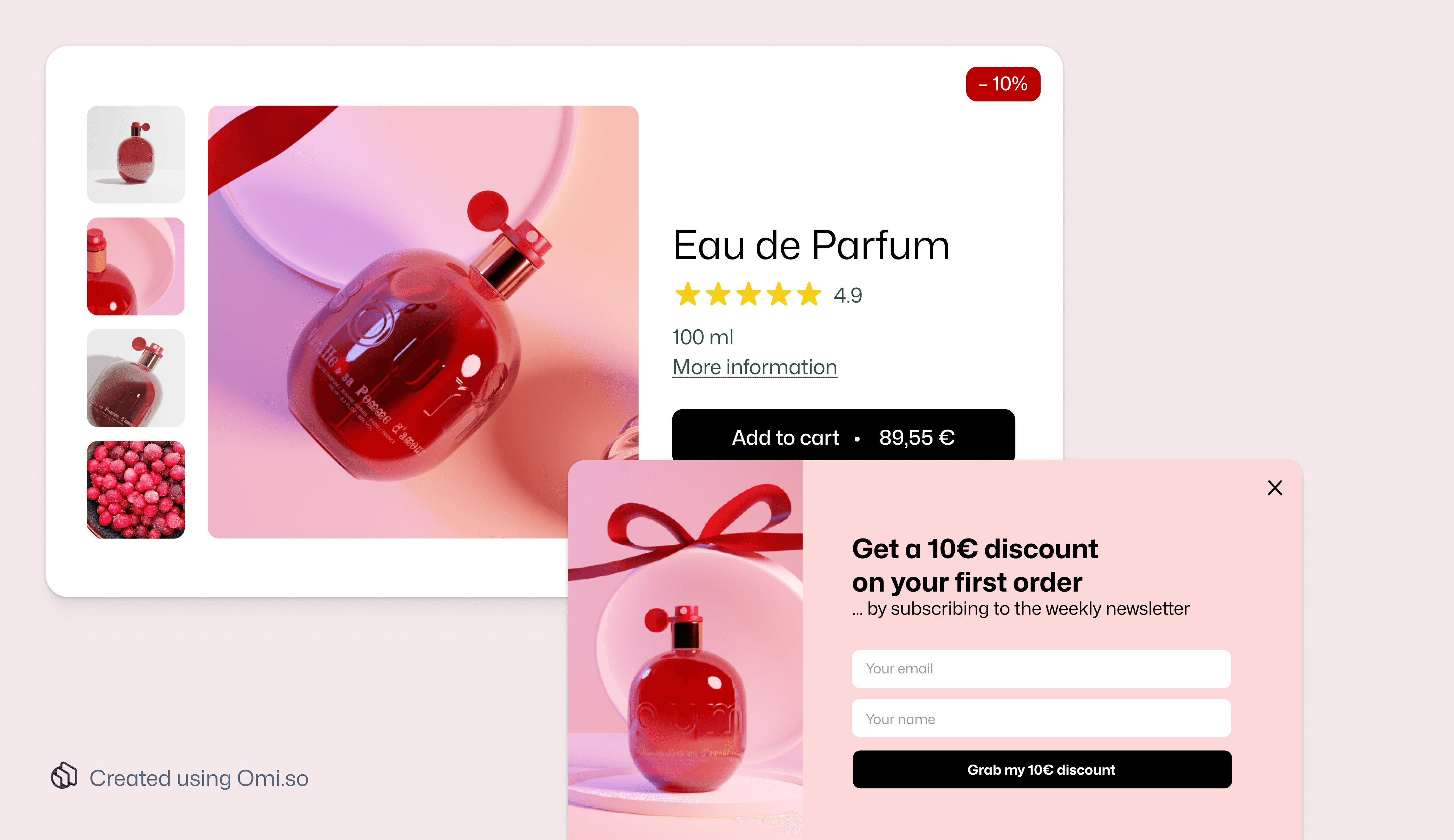High-Quality Product Imagery in eCommerce and Brand Marketing — How to Get it Right | Omi.so

Written by
Emma Head
Jun 25, 2025
Table of contents
High-Quality Product Imagery in eCommerce and Brand Marketing — How to Get it Right | Omi.so
Every second, millions of online shoppers are making multi-thousand dollar decisions based entirely on pixels. They can't pick up your products, feel the texture, gauge the size, or see how light plays off the surface. Instead, they're relying on humble packshot photography to bridge that physical gap.
Needless to say, quality product imagery is a cornerstone of successful eCommerce, directly impacting engagement rates, conversion metrics, and even return frequencies.
While brands have traditionally invested thousands in product photography costs (think: studios, equipment, and reshoots to create these crucial assets) the approach to product imagery is evolving rapidly. Leading brands are discovering that innovative methods like virtual photography aren't just more efficient than traditional approaches — they're actually improving the results while lowering costs.
How high-quality product visuals impact your bottom line
New products pop up every day. And as the competition gets fiercer, your product imagery needs to work harder than ever. For one, you need creative product photography to generate awareness and buzz. Some even use interactive solutions like 360° product photographs.
But these approaches are not about aesthetics — they're about answering questions (before they're asked), building purchase confidence without physical interaction, and driving curiosity across channels.
Think about what a single product photo needs to achieve:
Capture attention in crowded feeds
Showcase key features clearly on sales pages
Build trust through accurate, detailed representation
Help customers imagine ownership through e.g. lifestyle imagery
Drive action across different platforms with a wide variety of imagery

Get this right, and your imagery becomes more than just pretty pictures — it becomes a conversion engine. Get it wrong, and you're leaving money on the table. Here are 3 concrete ways high-quality product visuals transform your eCommerce performance:
Higher engagement rates
When it comes to eCommerce, visual quality drives engagement. Wei Di's extensive market research shows a direct link between image quality and transaction completion, especially in categories like fashion and electronics where visual presentation is key.
Plus, the gradual transition to mobile devices for shopping has led to the evolution of interactive or spinning imagery solutions such as 3D Viewers or 360 object photography that save screen space and involve the brain more.
But the classic types of product imagery still remain, and are often used in combination with each other.
Most online retailers mix lifestyle content with product photography to boost engagement rates. Endro Cosmétiques took this approach one step further by leveraging virtual photography: they actually discovered that 8 out of 10 of their best-performing static ads were created in Omi’s Virtual Photo Studio. Their success shows how emerging technologies are changing the game for product visualization.
Of course, what constitutes engagement varies by channel. On socials, engagement means continued exposure, shares, saves, or clicks. Naturally, creative product photography does this well. For eCommerce, however, engagement means making informed purchase decisions. Here, creativity takes a backseat so that clarity and detail may take the wheel — making white background product imagery a classic choice.
More conversions
Let's talk about how people really shop online. According to fresh research from Silesian University, we're all visual buyers at heart. In fact, their 2023 study found something interesting: 94.1% of online shoppers carefully evaluate product images before buying, and 83.6% say image quality directly influences their decision to purchase.
Makes sense, right? When you can't pick up a product and examine it in person, those images become your eyes, your hands — your whole shopping experience. Every detail matters: the lighting that shows true colors, the backgrounds that provide context, the angles that reveal key features.
Here's the good news: Virtual Studios like Omi are making it easier than ever to nail these crucial elements. Instead of spending days in a physical studio tweaking lights and rearranging sets, brands can now test different looks with a few simple clicks.
Fewer product returns
Here's a challenge every eCommerce brand knows too well: when customers can't physically interact with products, they rely entirely on visuals to make decisions. According to the 2023 Silesian University research, this "missing dimension of face-to-face communication" makes product photography one of your most powerful tools for setting the right expectations.
Think about what customers need to see before buying:
True-to-life colors
Clear sense of scale
Detailed features
Consistent representation across every angle

Jolt used Omi to show their new product in great detail to maximize sales and minimize returns.
The better they can see what they're buying, the more confident they'll be in their purchase. This is where virtual photography is changing the game. Tools like Omi use Digital Twin technology, combining photorealistic 2D imagery with interactive 3D views, to bring products to life on screen. The result? Return rates drop by 12%. It's not quite the same as holding the product in your hands, but it's pretty darn close.
Get product imagery right
Better conversions, engagement, and return rates
Best practices for creating high-quality product images
Nail the basics
When it comes to product photography, three elements make or break your image: lighting, angles, and backgrounds. According to the 2023 Silesian University study, shoppers are scrutinizing these details more than ever:
82% notice differences in lighting quality
67.7% assess image saturation
64.7% evaluate contrast levels
61.8% pay attention to color accuracy
Traditionally, perfecting these elements meant hours of studio setup and endless tweaks. But virtual photography is changing this. In Omi's Virtual Studio:
Lighting can be adjusted with precision to highlight product details
Multiple angles can be captured from a single 3D model
Backgrounds can be swapped instantly from a library of hundreds of options


Notice the difference a change in background makes.
The goal? To create images that bridge the gap between digital browsing and physical confidence — giving customers the next best thing to holding the product in their hands.
Adapt to different formats
Here's something every eCommerce brand knows: different platforms have different demands. Your website needs high-res product shots around 2000px wide. Instagram wants square crops at 1080x1080px. Email banners might need to be wide but slim. And marketplaces like Amazon? They have their own specific requirements entirely.
Traditionally, this meant either:
Ordering multiple versions of every shot
Manually cropping and resizing images later
Losing quality in the process
Paying extra for each format
But here's where virtual photography changes everything. With Omi's Virtual Studio, the same scene can be instantly exported in any format you need:
Crisp packshot photography for your product pages
Square crops for social media
Wide banners for your homepage
Vertical shots for Stories
Different angles for marketplaces
Even animations for ads

No more compromising on quality, no more waiting for new versions. Just set up your scene once, then export it however you need it. When your social team needs a new format? It's just a click away.
Stay consistent across channels
Moët Hennessy's approach to visual consistency shows what's possible when you get this right — and when you use Omi’s Virtual Studio. Across nine wine houses, they maintained perfect brand standards by:
Saving exact lighting setups for reuse
Creating pre-approved scene templates
Establishing clear visual guidelines
Sharing resources globally
Enabling local customization without compromising quality

Test faster, sell more
The most successful brands treat their product imagery as a creative canvas rather than a technical challenge. This means:
Testing multiple creative directions quickly
Trying different lighting setups instantly
Creating variations for different markets
Comparing options side by side
Launching stronger content, faster
In traditional photography, every creative test means another studio day and another round of costs. Virtual photography changes this equation: one 3D model becomes the source for unlimited creative iterations, letting teams experiment freely without the traditional trade-off between creativity and budget.
Tailor your targeting
When Daan Tech marketed their compact dishwasher, they faced a unique challenge: different customers loved their product for entirely different reasons. Their solution was to create targeted visuals for each audience:
Kitchen integration shots for home design enthusiasts
Eco-friendly feature highlights for sustainability-focused buyers
Mobile-focused scenes for van life customers
Technical detail shots for specification-driven shoppers
The result? They achieved a perfect 5/5 quality rating while creating three times more content than they could with traditional photography.

Consider context (and culture)
The key to effective lifestyle imagery is balancing aspiration with authenticity. Unique product photos for eCommerce (wether lifestyle or not) may bridge this gap by showing your products in conceptual, niche ways that spark the audience's imagination. But here's the challenge: how do you create that perfect kitchen shot for Germany, adapt it for Chinese New Year, and then transform it for a summer campaign in Brazil — all while keeping sticking to the brand kit?
Virtual photography makes this possible. As Moët Hennessy discovered, you can create pre-approved settings that maintain perfect brand standards while allowing local teams to customize. They even had Omi model a specific chair that perfectly captured their aesthetic (fun fact: that chair still lives in Omi's office!).
Do:
Match environments to your audience — from minimalist apartments to rustic kitchens
Keep lighting consistent across every variation
Show products in real-world scenarios
Add seasonal touches (Endro Cosmétiques updated their entire site for Christmas in just two days)
Maintain your brand's visual identity across markets


Fauchon uses Omi across catalog prints, emails, social, ads, and website for total brand consistency.
Don't:
Over-complicate scenes
Mix inconsistent styles
Ignore cultural preferences
Let backgrounds steal the show
Sacrifice product clarity
And here's the best part: Omi's assets libraries have thousands of scene props and contextual backgrounds for both creative product photography and classic white background shots. Whether you need a Mediterranean terrace bathed in golden light or a cozy winter setting with just the right festive touches, they're all at your fingertips.
Challenges in producing high-quality imagery
The traditional approach to product photography faces three major hurdles:
1) Traditional shoots drain resources
Multiple team members required
Complex equipment needs
Extensive post-production time
Revision cycle management
Storage and file handling
2) Consistency is a constant struggle
Varying studio conditions
Multiple photographer styles
Seasonal lighting differences
Different retail requirements
Cross-platform variations
3) Adapting to markets and platforms leads to costly delays
Slow response to market changes
Difficult spec updates
Costly seasonal refreshes
Complex marketplace compliance
Limited testing ability
But what if there was a way to bypass these traditional constraints entirely? Leading brands are discovering that virtual photography — where a single 3D model becomes the source for unlimited shots — is transforming how product imagery is created.

Switching to Omi’s Virtual Studio for product photography tends to lower costs dramatically. The bigger your needs, the bigger your savings.
Bye-bye, bottlenecks: why brands are switching to Omi’s Virtual Studio
Here's how Omi's Virtual Studio transforms the product photography process:
Create endless shots from one model
One 3D model, or Digital Twin, becomes the source for unlimited shots. Teams can:
Create new angles instantly
Test different lighting setups in minutes
Generate variations without reshoots
Produce content for every channel from one source
Cut costs without compromising quality
With virtual photography:
Less than $1 per image versus $50+ traditionally
No equipment or studio rental costs
Eliminate shipping and handling expenses
Reduce team time investment by 70%
Scale content without breaking a sweat
The numbers tell a clear story about what's possible with virtual photography:
Launch products globally without physical samples
Create content for every seasonal campaign in days
Support unlimited retail partners with custom assets
Adapt content instantly for regional markets
Scale production without increasing headcount

Esthederm’s product launch included 30+ visuals made with Omi: ads, banners, IG Stories, and videos.
Adapt and grow in record time
Daan Tech demonstrates the power of adaptability:
Created 3x more content with Omi
Achieved 5/5 quality ratings
Fed every channel with fresh content
Responded to market opportunities instantly

Here's what we've learned: winning at product imagery isn't about having the biggest studio or the fanciest equipment anymore. It's about having the freedom to try new ideas, respond to opportunities instantly, and never worry about the meter running on studio time.
The brands pulling ahead aren't necessarily the ones with the deepest pockets — they're the ones who can test ten different ideas before lunch and spin up a holiday campaign in an afternoon.
To start creating product imagery with Omi, you may want to check out the free version of our Virtual Studio. This includes everything except custom 3D models of your product (that’s what the subscription is for). That way, you can experience the magic of studio quality photography without leaving your desk. When and if you’re ready, it’s easy to order 3D models of your products.
Get product imagery right
Improve conversions, engagement, and return rates

About the author
Emma Head
-
Technical Writer, Product Imagery
Emma Head researches and writes about product photography, covering its role in eCommerce, social media, and digital advertising. She focuses on making complex topics accessible, helping brands and creators improve their visual content. In addition to this, she contributes to Omi's marketing, UX, and branding.



